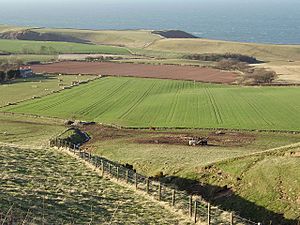Battle of Piperdean facts for kids
Quick facts for kids Battle of Piperdean |
|||||||
|---|---|---|---|---|---|---|---|
| Part of the Anglo-Scottish Border Wars | |||||||
 Site of the Battle of Piperdean, Old Cambus, from Piperdean Bridge |
|||||||
|
|||||||
| Belligerents | |||||||
| Commanders and leaders | |||||||
| Strength | |||||||
| 1,500-4,000 | 4,000 | ||||||
| Casualties and losses | |||||||
| up to 200 men | around 1500 killed | ||||||
The Battle of Piperdean was an important fight between Scotland and England. It happened on September 10, 1435, in the area known as the Scottish Borders. This battle was part of the ongoing conflicts between the two kingdoms at that time.
The English army was led by Henry Percy, 2nd Earl of Northumberland. He was joined by George de Dunbar, 11th Earl of March. Their goal was to take back Dunbar Castle, which had been taken by the Scottish forces. The castle was now held by William Douglas, 2nd Earl of Angus. Earl Percy and Earl Dunbar marched north with about 4,000 soldiers.
Earl Douglas, also known as the Lord Warden of the Marches, didn't want to wait for a long siege at the castle. Instead, he decided to surprise the English army on their way. He gathered a Scottish force of similar size. This army included brave leaders like Adam Hepburn of Hailes, Alexander Elphinstone, and Alexander Ramsay of Dalhousie.
The Scottish army launched a surprise attack. This led to a big victory for Scotland. While the exact numbers are a bit unclear, it's believed the Scots lost around 200 men. One of the fallen was Alexander Elphinstone. The English, however, suffered much heavier losses. Around 1,500 English soldiers were killed, including 40 knights.
After the battle, Earl Percy retreated to Alnwick Castle in England. But he didn't stay away from Scotland for long. Soon after, he returned to help relieve Roxburgh Castle. This castle was under siege by the Scottish king, King James.
Contents
Where Did the Battle Happen?
Historians have different ideas about the exact spot of the Battle of Piperdean. Finding the precise location of old battles can be tricky!
Early Ideas About the Battle Site
George Ridpath, a historian writing in 1776, said the battle happened near a place called Pepperden. He mentioned it was "on Brammish" and "not far from the mountain of Cheviot." The Breamish is a river that starts in the Cheviot Hills. This area was part of the Earl of Northumberland's land.
Modern Research on the Location
Because of Ridpath's description, some people think the battle was near Wooler. This town is in Northumberland, England. There is no official record of a battle site at Auld (or Old) Cambus in Scotland. However, some old papers from the Earl of Home say it happened near Dunglass.
The Department of Archaeology in Northumberland County Council has another idea. They believe the battle took place at Piperdean on the Pressen Burn. This is near a place called Wark. The exact map reference for this spot is NT8400635899. This location is also mentioned in the records of the Berwickshire Naturalists. So, while there are different theories, the area near Wark is a strong possibility.
Sources
- Brenan, Gerald-A History of the House of Percy-Freemantle, London 1902
- Maxwell, Sir Herbert-A History of the House of Douglas-Freemantle, London 1902
- Ridpath, George-The Border History of England and Scotland-Edinburgh, London, Berwick 1776
- HMSOThe Manuscripts of the Duke of Athole, K.T., and of the Earl of Home, London 1891 [1]

